A force of nature
When institutions threw up constraints, Melanie Winter's tenacity surged — just like the river she championed
When institutions threw up constraints, Melanie Winter's tenacity surged — just like the river she championed

When Melanie Winter became the director of the advocacy group Friends of the Los Angeles River in 1997, the only way to use the Los Angeles River was by entering it illegally. So she did: surreptitiously slipping behind chain-link fences with a gaggle of co-conspirators who made kayak trips down what was then considered to be a flood control channel. What appeared to be a wacky stunt was actually a brilliant political gambit. The boating excursions forced federal agencies to declare the 51-mile waterway navigable, unlocking the funds for its revitalization, and allowing the establishment of recreational zones that finally granted Angelenos legal access to their river. Melanie didn't do this because kayaking the river was fun — although it is, 10/10, highly recommend — it was because she knew that, for most Angelenos, a slow paddle along one of the river's soft-bottom corridors was all they needed to be indoctrinated. You couldn't fully grasp the river's potential unless your feet were wet, gliding among the herons, freeways shushed by the rustling of the sycamores. Here on a gravel bar, Melanie could enlist you in the vision that would become her life's work: "unbuilding" the river with hundreds of parks clustered along its banks and throughout the LA basin.
When Melanie died last month after a battle with lung cancer, that work was nowhere near finished. But it often felt like she was operating on a geological time scale. The federal river designation easily took a dozen years. Legislation and lawsuits spanned decades. Reversing harmful infrastructural decisions could be a century (or more). Sometimes she would be the sole constituent who showed up to public meetings for an agenda item that had long fallen off everyone else's radars, staring down the decision-makers with what could be a frightening intensity. She never let up. "She had such strength of her convictions, and she was so clear-eyed in the vision that she wanted to push forward," as Rita Kampalath, LA County’s chief sustainability officer, described her in a stirring Los Angeles Times obituary by Ian James. When institutions threw up constraints, Melanie's tenacity surged — just like the river she championed.
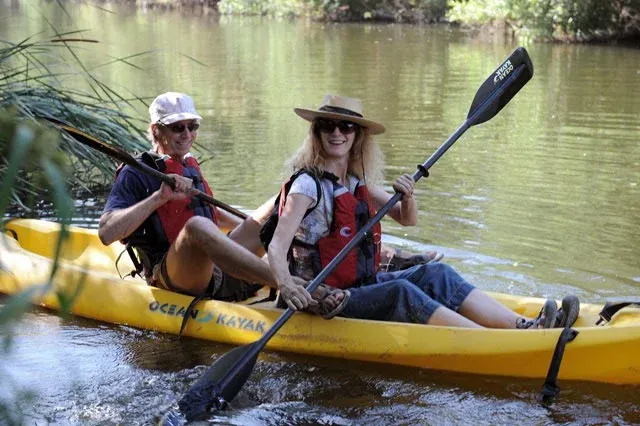
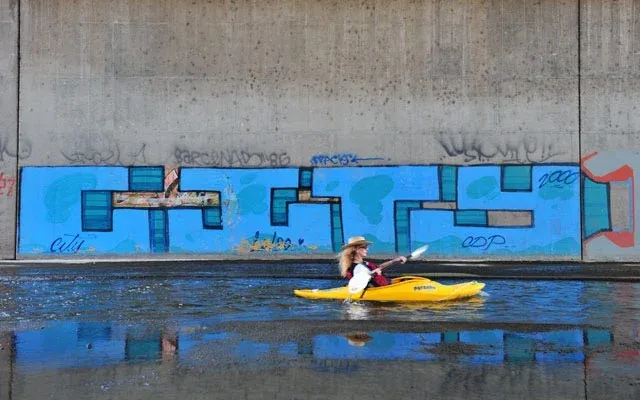
“I think it just freaks people out to see boats in concrete parts of the river," Melanie said in 2011. "They've told themselves that there's no water in it, so it causes a lot of cognitive dissonance.” The River Project
"Melanie never accepted 'later,'" Candice Dickens-Russell, current Friends of the Los Angeles River director, wrote earlier this month. "She believed the river should be healthy now, that people living along it deserved access now, that nature and justice could not wait for convenience. She wanted us to move faster, be braver, and stop apologizing for wanting more for the river.”
She also wanted us to understand that no matter where we lived, the river touched our lives. In 2001, Melanie started The River Project, a name which I always thought was intended to serve as a snap assessment of your water knowledge. You think you know about LA's river, do you? Well, Melanie was here to tell you about allllll the rivers in LA County. What watershed are you in? she'd inquire casually, like she was asking where you went to high school. If you didn't know, she'd give you a map and a lecture on your upstream responsibilities. According to Melanie, the river began on your street, in your yard, or, more specifically on your roof. The river is LA; LA is the river.

Being such a staunch protector of LA's riparian lands put Melanie in diametric, and often confrontational, opposition to local officials. When a starchitect who had no business drawing up a master plan for the river claimed the concrete could not be removed, Melanie's team put together their own restoration feasibility study for the Valley that showed what was possible. Creating the 247-acre Rio de Los Angeles State Park required a years-long court battle to wrestle a former Cypress Park freight railyard back from the city. She was an evangelist for the Sepulveda Basin — "Where else in Los Angeles can you sit on a legitimate riverbank and stick your toes in the water?" she told the LA Daily News — and believed the plans to erect a temporary extreme sports complex there would endanger future revitalization efforts. She viewed LA’s inability to advance its environmental agenda as a personal affront to her advocacy, and went into fury mode when city administrators tried to eradicate the Climate Emergency Mobilization Office that she fought so hard to establish. (It was eventually reinstated, as was the funding for a climate action plan.) Last week, as LA's City Council was adjourned in her memory, I had to giggle a bit as the moment also marked a reprieve for the beleaguered council office staffers who no longer had to field her frequent, sharply phrased criticism.

And yet — she was always right. Talking with Melanie during the second-wettest back-to-back years in LA history felt like speaking to a prophet. (Her social media bio did warn us she'd be predicting the future: "autodidact, generalist, synthesist, rabble-rouser, naiad, cassandra.") After years of drought had inured us to barren catch basins and bathtub-ringed reservoirs, we were given a front-row seat to witness LA's potential as a sponge city — and how poorly we had prepared for this moment. The river that filled to a frothy, chocolate-milk brim was just as swiftly sluiced out to the Pacific in a sludgy, plastic-strewn stew. Finally, here was the water! Wait, where was all that water going?
The ideas put forth by Melanie to keep LA's water local — to unpave the city, to make the impervious permeable, to sprinkle the region with distributed, nature-based stormwater projects — were eventually embraced (although she would say half-heartedly) by LA County through the adoption of Measure W. When I went to her as a source while reporting a story about LA alleys designed to mitigate flooding, she pushed me to see past the infrastructure and interrogate the problems with the policy. The interventions dreamed up by public works departments were overthought and overwrought, she argued. Why were we spending millions funding such projects when the answers were so much simpler?
Instead, she pointed me towards a median project her team had completed almost a decade before, with very little money, to transform a mile of parkway near the Tujunga Wash:
The most important technology deployed here is not a complex underground cistern or even interlocking permeable pavers, says Winter, it’s those tiny notches in the curb that allow runoff from the gutter to filter over some stones and into a native-planted garden with decomposed granite and sycamore trees. These projects can cost a few thousand dollars and be completed in a matter of months.
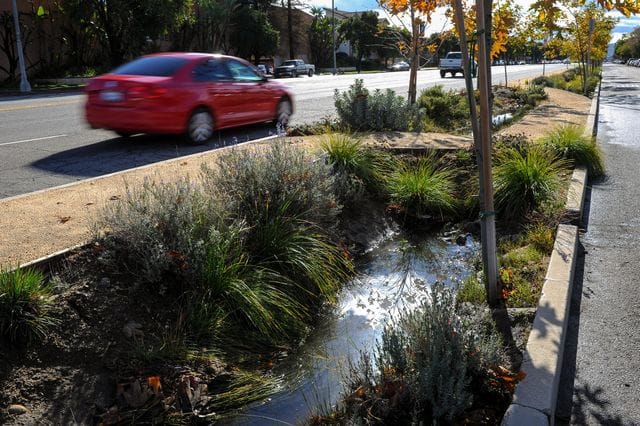
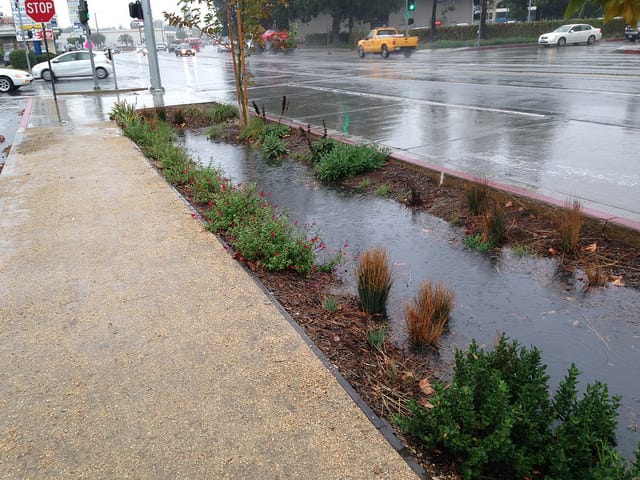
“Every parkway becomes a habitat that recharges groundwater, mitigates flood risk, and supports street trees without potable water," as Melanie envisioned it. The River Project
But if it's really as simple as a notch that nudges the water to the green side of the curb, I asked Melanie, why isn't the city doing this on every median?
She laughed. "They've not replicated it because it's too simple — simple scares them," she said. "Hell, nature scares them."
I've thought about that quote so much as I've observed LA's megaevent inertia. The biodiversity corridors that LA28 can't commit to, the car-free trails the city won't endorse, the street trees that no agency will plant — they're all so much simpler, cheaper, and easier than the alternatives.
And yet, as Melanie would tell you, we're fighting against nature instead of finding the notch.
I last saw Melanie at the Torched party in September, along with her +1 pup Maisie, of course. Although Melanie remained a fixture on Zoom organizing calls to the end, her attendance at in-person events had become sporadic, and for many people at the party, it was both the first time they had seen her in a long time, and also the final time. Melanie spoke openly about her illness while acknowledging the end was likely near, says UCLA water policy expert and ShadeLA co-founder Edith de Guzman. "In her trademark spirited tone, she didn’t hold back, asked incisive questions, and made strongly worded suggestions that showed the gumption we’ve all come to know was still very much intact," she told me this week. "Passionate and resolute in every respect, Melanie was a hell of an advocate for the LA we dream of and deserve — and her contributions toward realizing that vision are a legacy that will live on for decades. We should all be so lucky to leave such an indelible mark."
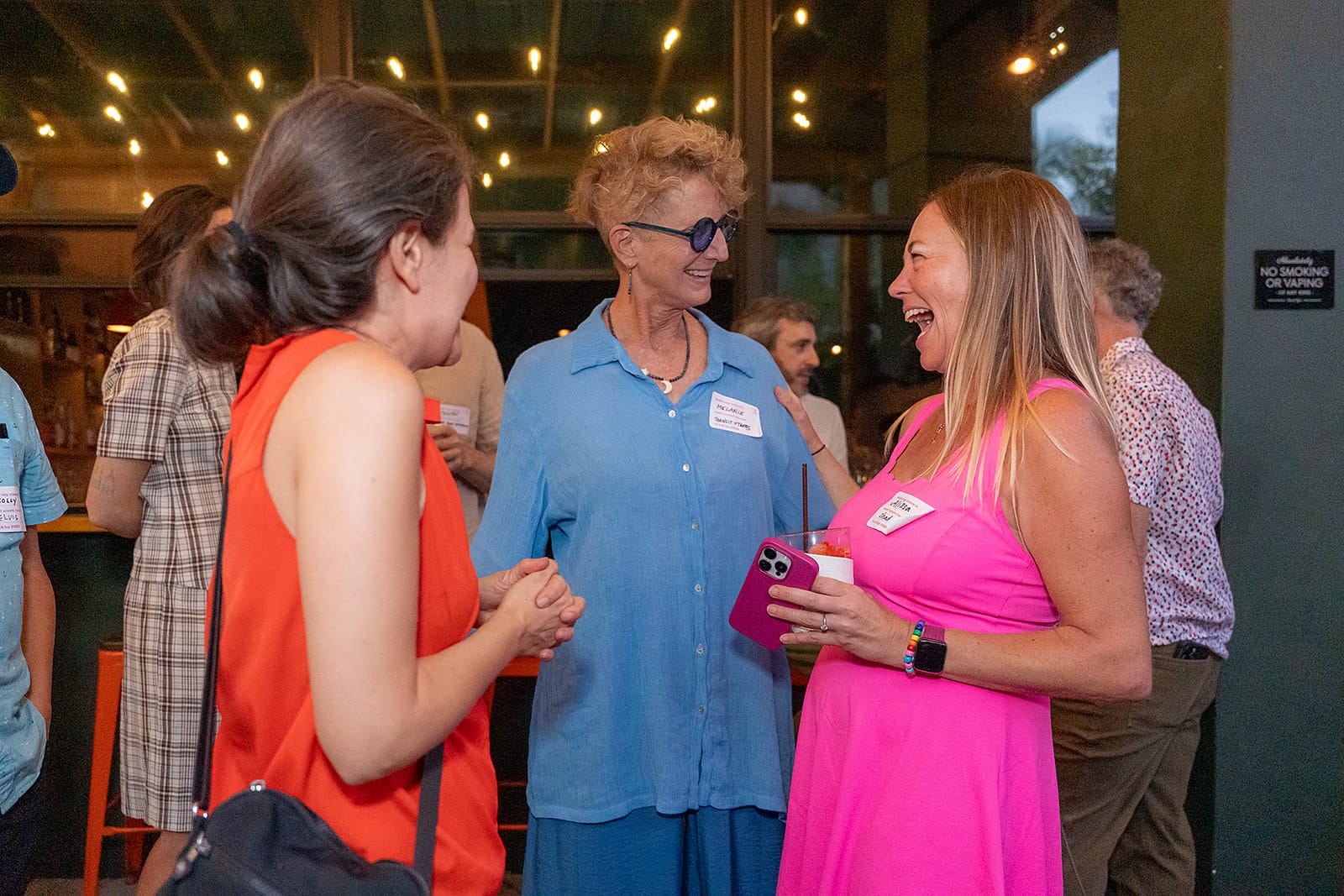
This week, as atmospheric rivers swamped the gutters in my neighborhood — the river is LA; LA is the river — I tugged on a pair of rainboots for my usual ritual of clearing Doritos wrappers from my local storm drains. But this time, in Melanie's honor, I also started plotting where to bash open the curbs and blow holes in the pavement. The LA that Melanie envisioned is not only possible, it's inevitable. But it's up to us to carve out the notches. 🔥